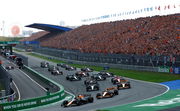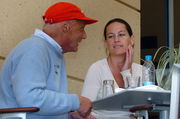
Getty
SAO PAULO, BRAZIL – NOVEMBER 25: Sebastian Vettel of Germany and Red Bull Racing celebrates with team mates on the podium as he finishes in sixth position and clinches his third consecutive drivers world championship during the Brazilian Formula One Grand Prix at the Autodromo Jose Carlos Pace on November 25, 2012 in Sao Paulo, Brazil. (Photo by Paul Gilham/Getty Images)

Getty
SAO PAULO, BRAZIL – NOVEMBER 25: Sebastian Vettel of Germany and Red Bull Racing celebrates with team mates on the podium as he finishes in sixth position and clinches his third consecutive drivers world championship during the Brazilian Formula One Grand Prix at the Autodromo Jose Carlos Pace on November 25, 2012 in Sao Paulo, Brazil. (Photo by Paul Gilham/Getty Images)
Overtaking in Barcelona is never easy. But sometimes the fewer overtaking opportunities can help a driver win a race. Point in case being Sebastian Vettel in 2011, when he had a KERS failure and had to hold off a charging Lewis Hamilton.
Watch What’s Trending Now!
Speaking to the press after the race, the Red Bull driver noted that it was hard work keeping the Briton behind. Sebastian Vettel took the fourth win of his 2011 season in Spain.
Throwback to 2011 in Barcelona where Seb had to hold back a charging Lewis while having to deal with the failing KERS system yet still managing to win the race 🐐 pic.twitter.com/HmMsavxEIF
— auz (@purplesectorz) May 17, 2022
ADVERTISEMENT
“McLaren was very strong, Lewis was very strong in particular. They stay out a little bit longer, a different strategy which brought them up to second behind us. And from then onwards I knew it will be very, very close.”
Sebastian then exclaimed that the last ten laps were intense as his tires were going. He also prayed the same thing happened to Lewis because Hamilton was catching Vettel via the DRS.
ADVERTISEMENT
Another factor that the reigning world champion in 2011 had to worry about was his KERS wasn’t working. The KERS was working at times but not all the time. This also allowed Lewis to catch up and put pressure on Sebastian.
“We had sometimes KERS on, sometimes KERS off, I was flicking around with the buttons and brake distribution. So it wasn’t an easy race and obviously, the McLarens and Lewis especially gave us a very, very hard time.
ADVERTISEMENT
“But it’s quite a big release when you cross the line and you open onto the main straight and you know there’s the chequered flag and we made it.”
Do F1 cars today use KERS?
So what is KERS? It stood for Kinetic Energy Recovery System and the FIA introduced it for developing greener technologies.
ADVERTISEMENT
Simply put, the friction generated due to braking is stored in order to drive the car in either the battery or any other way teams chose back in the day. This gave the engine more power. Usually, the KERS gave a 60-kilo watt boost to the cars for a little over 6 seconds each lap.
ADVERTISEMENT
However, modern F1 cars do not have KERS anymore, but an upgraded version of it. Known as ERS or Energy Recovery System, it is more complex compared to the KERS. The ERS has two components called MGU-K (Kinetic) and H (Heat) where MGU stands for Motor Generator Units.
Top Stories
“Have Some Shame”- Fans Tear Apart F1 Pundits’ Shocking 2025 Driver Ranking

Hollywood Star Not Holding Back Against Zak Brown in Lando Norris Championship Fiasco

Helmut Marko Drops Bombshell Claims Against Christian Horner Over Red Bull Power Grab Conspiracy

Who Is Lando Norris’ Girlfriend? Everything You Need to Know About Margarida Corceiro

3 Years After His Death, Niki Lauda’s Wife Brutally Disrespects Him to Initiate $32,000,000 Battle Against Own Children

Both the MGU-K and MGU-H are complemented by a system called Energy Store or ES. All this combined, the ERS gives a 120-kilo watt boost for approximately 33 seconds a lap.
ADVERTISEMENT
WATCH THIS STORY: Sebastian Vettel’s Hair Transformation Steals the Limelight
So while modern F1 cars do have KERS, it is a more complicated version of it.
ADVERTISEMENT
ADVERTISEMENT
ADVERTISEMENT

